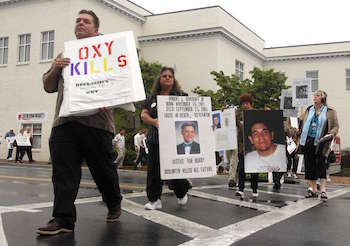A new report sheds light on how the US pharmaceutical industry has poured millions of dollars into an effort to stop public health measures aimed at curbing over-prescription of opioid drugs, indirectly feeding the US heroin epidemic and Mexico’s deadly boom in heroin production.
The investigation by The Center for Public Integrity and the Associated Press found that drugmakers employ “hundreds of lobbyists and millions in campaign contributions to help kill or weaken measures” aimed at curbing a drug abuse crisis “that has cost 165,000 Americans their lives and pushed countless more to crippling addiction.”
As public health advocates — some of whom had lost children to overdoses — testified in state legislature hearings about the need to regulate pharmaceutical opioids like OxyContin, Vicodin and fentanyl, industry lobbyists went door to door in state houses in an effort to quash the proposals via one-on-one talks with representatives.
The investigative report says companies spent more than $880 million from 2006 to 2015 on the lobbying effort and campaign contributions, “more than eight times what the formidable gun lobby recorded for similar activities during that same period.” Dr. Andrew Kolodny, an advocate for opioid reform, told the researchers that drug companies and their lobbyists “are reaping enormous profits from aggressive prescribing.”
The reform groups formed by the families of young people killed by opioids spent about $4 million nationwide from 2006 to 2015, the report says. It notes that sales of prescription opioids quadrupled from 1999 to 2010 “and overdose deaths rose just as fast.”

Graphic c/o AP and The Center for Public Integrity
The second installment of the investigative report notes that the US Center for Disease Control (CDC) has been tracking a precipitous rise in painkiller overdoes for 15 years, “which has been followed by a similar surge in heroin deaths.” The CDC began referring to the painkiller trend as an epidemic in 2011.
The report relies on anecdotal evidence to illustrate the connection between prescription opioids and heroin use, citing examples of teenagers who were prescribed opioids after incurring sports injuries and developed addictions. When their prescriptions ran out, they turned to the black market for the pills and eventually to heroin, which is cheaper, eventually dying of heroin overdoses. (See video below)

InSight Crime Analysis
InSight Crime Co-director Steven Dudley cited increased opioid prescriptions as a factor contributing to increased heroin consumption in the United States in May 2016 testimony before the Senate Foreign Relations Western Hemisphere subcommittee about Mexican drug cartels. Dudley testified that the US market for heroin was worth an estimated $27 billion in 2014, and that the number of consumers for the drug has more than doubled since the early 2000s.
“Mexican, Guatemalan and Colombian criminal organizations have reacted to these changes by producing more heroin,” Dudley told the senators.
He cited US Drug Enforcement Administration (DEA) estimates that Mexican production of poppy, the raw ingredient for the production of heroin, increased from 10,500 hectares in 2012 to 17,000 hectares in 2014, giving the crime groups there the potential to produce 42 metric tons, up from 26 metric tons in 2012. (pdf)
SEE ALSO: Coverage of Heroin
Violence generated by those groups and the Mexican government’s response to them contributed to approximately 33,000 deaths in 2015, a figure higher than the death toll in war-torn countries such as Iraq and Afghanistan, according to the 2016 Global Peace Index. In considering the wisdom of restrictions on the prescription of pain medications, US policy makers should take into account the collateral damage caused by opioid abuse on both sides of the border.

